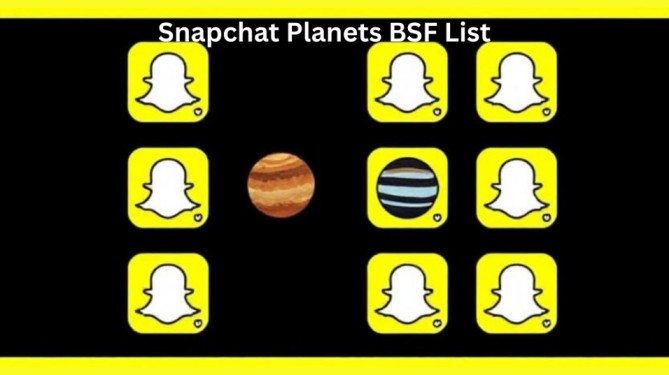Snapchat has always been more than just a platform for sharing snaps and stories. Over the years, it has evolved into a social space where friendships are measured, tracked, and represented in unique ways. One of the most talked-about features today is the Snapchat Planets BSF List, a playful, planetary-themed system that assigns meaning to your closest friendships on the app.
This guide provides a comprehensive and objective analysis of the concept, unpacking the BSFs meaning, how the BSF list planet order works, and the implications of relying on digital tools to measure personal relationships. We’ll also look at the tradeoffs and challenges of interpreting the planet BSF list and explore what it means for Snapchat users trying to make sense of their online social circles.
What Does BSF Mean? Understanding the Basics
Before diving into the planetary rankings, it’s important to clarify BSFs meaning.
- BSF stands for Best Friend. On Snapchat, BSFs are people you interact with the most through snaps, chats, and stories.
- The app tracks activity patterns, frequency of snaps, chats exchanged, and story replies to determine who qualifies as a best friend.
- Unlike traditional friendship labels, Snapchat’s system is dynamic. A person who is your BSF today might not hold the same position tomorrow, as the snap BSF list changes based on usage.
In short, BSFs meaning on Snapchat is tied directly to activity, not emotional closeness. This distinction is central to understanding why the BSF list planet order sparks so much debate among users.
The Snapchat Planets BSF List: What It Represents
The Snapchat planets BSF list is a gamified ranking system inspired by astrology and planetary order. It places your best friends on a virtual “solar system,” assigning each one a planet based on how close they are to you on the app.
Here’s the general structure:
- Mercury – Your #1 BSF, the person you interact with most.
- Venus – The second closest friend.
- Earth – Third spot on the list.
- Mars – Fourth in line.
- Jupiter – Fifth ranked BSF.
- Saturn – Sixth ranked BSF.
- Uranus – Seventh spot.
- Neptune – Eighth BSF, rounding out the list.
This system creates a visual and symbolic representation of friendships, making it easy for users to see where they stand with others.
The BSF List Planet Order: Key Factors That Shape It
The bsf list planet order isn’t random; it’s based on multiple factors that Snapchat uses to measure digital closeness.
1. Frequency of Snaps
The more snaps exchanged between two users, the higher the ranking. Snapping daily increases the chance of securing a top planet spot.
2. Chat Volume
Direct chats, especially those with quick replies, strongly influence BSF placement. Even without frequent snaps, chat-heavy interactions can elevate rankings.
3. Engagement with Stories
Watching and replying to stories adds another layer of interaction that affects the planet BSF list.
4. Consistency Over Time
Snapchat rewards consistent patterns. A friend you interact with regularly over weeks will rank higher than someone you engage with intensely but briefly.
The Tradeoffs of Measuring Friendships Digitally
While the snap BSF list is fun and interactive, it comes with tradeoffs.
Tradeoff 1: Activity vs. Authenticity
- Pro: It reflects active connections.
- Con: It doesn’t measure emotional closeness. A sibling you rarely snap may rank lower than a casual acquaintance you snap daily.
Tradeoff 2: Transparency vs. Privacy
- Pro: Users can easily see who their closest friends are.
- Con: The visibility of rankings can spark tension or jealousy in relationships, especially when rankings change suddenly.
Tradeoff 3: Dynamic Rankings vs. Stability
- Pro: The fluid nature keeps the system engaging.
- Con: Rapid changes may feel unstable or undermine the meaning of “best friends.”
These tradeoffs highlight the challenge of balancing accuracy, privacy, and user satisfaction in designing a digital friendship tracker.
Challenges with the Snapchat Planets BSF List
Snapchat’s planetary approach raises several challenges for both users and the platform itself:
- Over-interpretation of Rankings
Users may overanalyze the bsf list planet order, assigning emotional weight to positions that are purely algorithm-driven. - Pressure to Maintain Interactions
Friends may feel pressure to snap constantly to “stay in orbit,” leading to artificial communication. - Exclusion and Jealousy
Those not on the planet’s BSF list may feel excluded, creating unnecessary friction in friendships. - Algorithmic Bias
The system favors certain types of engagement (snaps over real-life closeness), which can misrepresent the actual strength of a bond.
The Psychology Behind the BSF List Planet Order
The snapchat planets bsf list taps into basic human psychology:
- Gamification: Turning relationships into a planetary ranking system makes it feel like a game, increasing user engagement.
- Social Comparison: People naturally compare their positions, fueling curiosity and sometimes anxiety.
- Validation: Being ranked as Mercury (the closest friend) offers a sense of recognition and validation.
This mix of excitement and anxiety explains why the planet bsf list garners so much attention.
How to Balance the Factors in the BSF List
To make sense of the bsf list planet order, it’s important to approach it with balance:
- Recognize the Algorithmic Nature
Understand that placements reflect digital activity, not the depth of personal connection. - Avoid Overemphasis
Don’t let rankings define the value of friendships. They’re a snapshot of activity, not a full picture of closeness. - Communicate Openly
If rankings cause confusion, have an honest conversation with friends about how the system works.
Broader Implications of Snapchat’s BSF System
The snap bsf list doesn’t just affect individual users it has broader implications:
- Cultural Impact: It shapes how younger generations think about friendship and validation.
- Digital Well-being: Overreliance on rankings can increase anxiety and decrease genuine communication.
- Platform Loyalty: The gamified approach keeps users invested in Snapchat, ensuring daily engagement.
By gamifying friendship, Snapchat is setting new norms for how relationships are tracked and understood online.
Conclusion: Navigating the Planetary Friendship System
The Snapchat planets BSF list offers a fascinating, if imperfect, way to visualize friendships. It combines data-driven algorithms with playful design, transforming ordinary activity into symbolic planets. While it sheds light on who you interact with most, it also raises important questions about BSFs meaning and the tradeoffs of ranking friendships digitally.
When considering the bsf list planet order, users should remain aware of the limitations. The planets reflect activity, not the depth of emotional connection. Balancing engagement with perspective is key to using the system in a healthy way.



